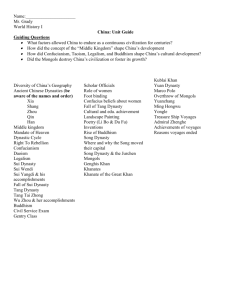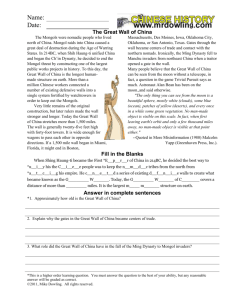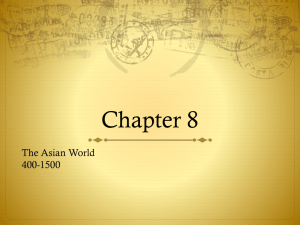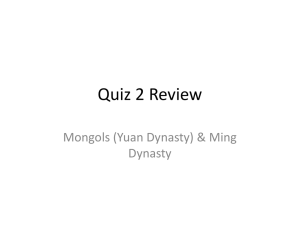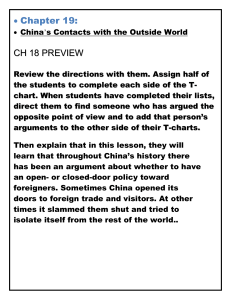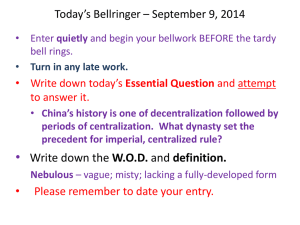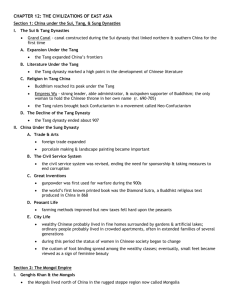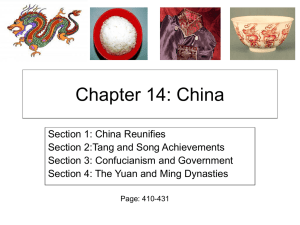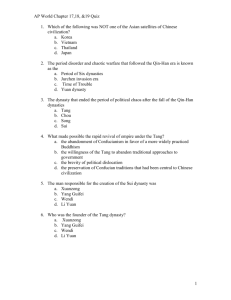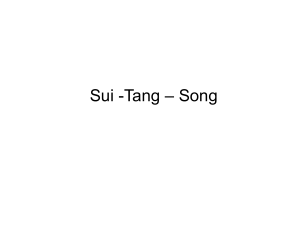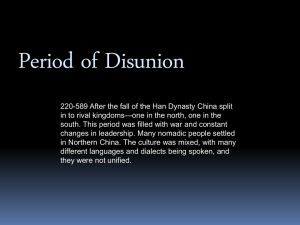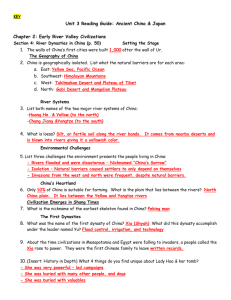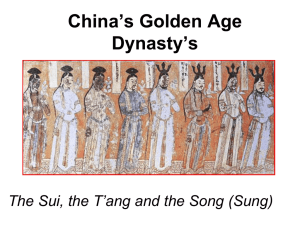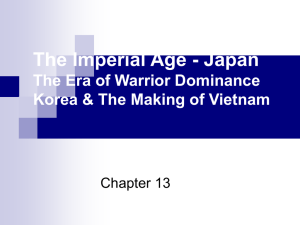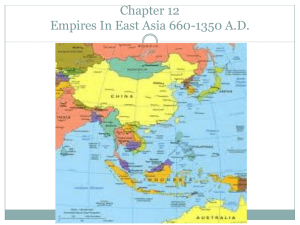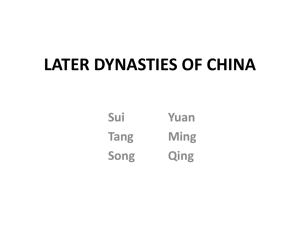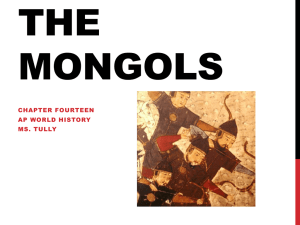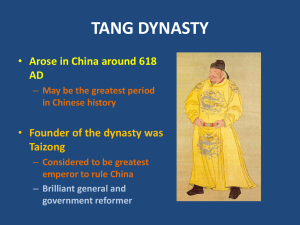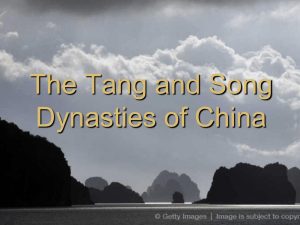Chapter 8 - Somerset Academy
advertisement
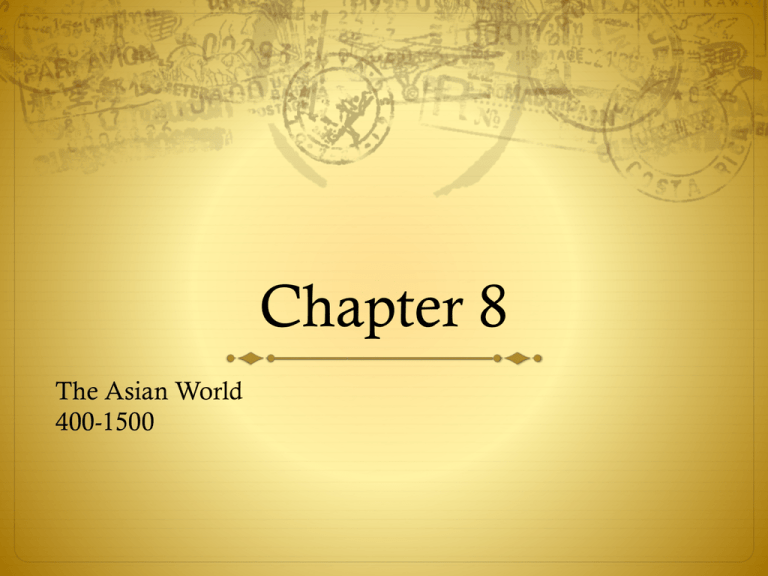
Chapter 8 The Asian World 400-1500 China Reunified Han Dynasty ended in 220 and left China with disorder and civil wars for 300 years until the Sui Dynasty formed in 581. Sui (581-618) Tang (618-907) Song (960-1279) Sui Dynasty (581-618) Unified China under the Emperors rule Sui Yangdi, the second emperor of the dynasty, completed the Grand Canal that linked the two great rivers of China, the Huang He (Yellow River) and the Chang Jiang (Yangtze River) Forced labor, high taxes, his extravagant and luxurious lifestyle, and military failures, caused a rebellion Tang Dyansty (618-907) They tried to create a more stable economy by giving land to the peasants and breaking up the power of the owners of the large estates They also restored the civil service examination from earlier times to serve as the chief method of recruiting officials for the civilian bureaucracy. (only 1 in 5 would pass) Emperor Tang Xuanzang (SHWAHN• DZAHNG) is remembered for his devotion to a commoner’s daughter, Yang Gul Fei. The emperor ’s favorite general led a bloody revolt and the army demanded that someone be held accountable for the war and strife in the country. Song Dynasty (960-1279) The Song ruled during a period of economic prosperity and cultural achievement. Song rulers were forced to move the imperial court farther south to Hangzhou. During the 1200s, the Mongols, a nomadic people,from the Gobi, carried out wars of conquest and built a vast empire, within 70 years the Mongols overthrew the Song and created a new Mongol dynasty in China. The Mongols and China The Mongols Religion and Government A Golden Age in Literature and Art The Mongols The Mongols brought much of the Eurasian landmass under a single rule, creating the largest land empire in history. After the death of Genghis Khan in 1227, his heirs divided the territory into several separate territories called khanates, each under the rule of one of his sons. Genghis Khan’s grandson Kublai Khan ruled China and established his capital at Khanbalik later known by the Chinese name Beijing. The capital at Khanbalik reflected Mongol prosperity and it was a magnificent city that impressed foreign visitors. One such visitor was Marco Polo, who lived in Khanbalik during the reign of Kublai Khan. The Mongols Mongol armies advanced into Vietnam,Java, Sumatra and twice against the islands of Japan but only Vietnam was conquered. The Mongols used tactics, such as cavalry charges and siege warfare. The Mongol dynasty eventually fell victim to the same problems that had plagued other dynasties: too much spending on foreign conquests, corruption at court, and growing internal instability. In 1368 Zhu Yuanzhang (JOO YWAHN•JAHNG), the son of a peasant, put together an army, ended the Mongol dynasty, and set up a new dynasty, the Ming. Religion and Government Confucian principles became the basis for Chinese government during the Han dynasty. Buddhism and Daoism had more influence during the Sui and Tang dynasties. After the Han dynasty collapsed people lost faith in Confucianism and Buddhism became a more attractive offer. The government embraced Buddhism until there was corruption. Buddhism also went against the virtues that the government supported. Neo-Confucianism was developed as a response to Buddhism. It embraced a physical and spiritual world, It teaches that the world is real, not an illusion, and that fulfillment comes from participation in the world. Lasted in China until 20th Century. A Golden Age in Literature and Art The Tang dynasty is viewed as the great age of poetry in China. Chinese poems celebrated the beauty of nature, the changes of the sea- sons, and the joys of friendship. They expressed sadness at the shortness of life and the necessity of parting. Li Bo was a free spirit whose writing often centered on nature, Du Fu was a serious Confucian Poet During the Song and Mongol dynasties, landscape painting reached its high point. Influenced by Daoism, artists went into the mountains to find the Dao, or Way, in nature. The word landscape in Chinese means “mountain-water” and reflects the Daoist search for balance between the earth and water. Early Japan and Korea Japan is mountainous and only about 11 percent of the total land area can be farmed. The mountains are volcanic in origin. Volcanic soils are very fertile, which has helped Japanese farming but it is prone to earthquakes. Chinese Influences In the early seventh century, Shotoku Taishi, a Yamato prince, tried to unify the various clans so that the Japanese could more effectively resist an invasion by the Chinese. He sent representatives to China to learn how China did things. Shotoku Taishi used the information to increase his own power and lessen the aristocrats power. All farming belonged to the state so taxes were to be paid directly to the central government rather than to local aristocrats. Nara Period Political power fell into the hands of the Fujiwara clan. Japan’s central government could not overcome the power of the aristocrats. These powerful families were able to keep the taxes from the lands for themselves. Unable to gain tax revenues, the central government steadily lost power and influence. Heian Period Power remained in the hands of the Fujiwara clan. With the decline of central power, local aristocrats took justice into their own hands. They turned to military force, and a new class of military servants emerged, called the samurai, whose purpose was to protect the security and property of their employers. Kamakura Shogunate By the end of the twelfth century, rivalries among Japanese aristocratic families had led to almost constant civil war. Minamoto Yoritomo defeated several rivals and set up his power near the modern city of Tokyo. To strengthen the state, he created a more centralized government under a military leader known as the shogun. After surviving an attack from the Mongols, Kamakura Shogunate was overthrown by a group of powerful families led by the Ashikaga family in 1333. Life in Early Japan Early Japan was mostly a farming society. In early Japan, women may have had a certain level of equality with men, but later women were considered subordinate to men. A husband could divorce his wife if she did not produce a son or if she committed adultery, talked too much, was jealous, or had a serious illness. Shinto and Buddhism are the religions practiced. Women wrote prose fiction. Landscape art was popular. The Emergence of Korea The Korea Peninsula, only slightly larger than the state of Minnesota, is relatively mountainous. Three separate kingdoms emerged: Koguryo in the north, Paekche (PAK•chuh) in the southwest, and Silla in the southeast. In the thirteenth century, the Mongols seized the northern part of Korea. Mongol rule led to much suffering for the Korean people In 1392 Yi Song-gye, a military commander, seized power and founded the Yi dynasty, which would rule Korea for over five hundred years.
